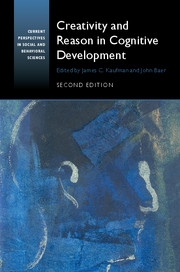Book contents
- Frontmatter
- Dedication
- Contents
- List of Contributors
- Acknowledgments
- 1 Creativity, Reason and Cognitive Development: Ten Years Later
- SECTION ONE CREATIVITY AND REASON IN CHILDHOOD AND THE SCHOOLS
- SECTION TWO CREATIVITY AND REASON IN COGNITION AND NEUROSCIENCE
- SECTION THREE CREATIVITY AND REASON: INTERACTIONS AND RELATED CONSTRUCTS
- 14 Opening up Creativity: The Lenses of Axis and Focus
- 15 Creativity and Reason: Friends or Foes?
- 16 Creative Self-Beliefs: Their Nature, Development, and Correlates
- 17 Individual Differences in Intelligence, Personality, and Creativity
- 18 An Update on “Does Culture Always Matter”: For Creativity, Yes, for Deductive Reasoning, No!
- Author Index
- Subject Index
- References
14 - Opening up Creativity: The Lenses of Axis and Focus
from SECTION THREE - CREATIVITY AND REASON: INTERACTIONS AND RELATED CONSTRUCTS
Published online by Cambridge University Press: 05 February 2016
- Frontmatter
- Dedication
- Contents
- List of Contributors
- Acknowledgments
- 1 Creativity, Reason and Cognitive Development: Ten Years Later
- SECTION ONE CREATIVITY AND REASON IN CHILDHOOD AND THE SCHOOLS
- SECTION TWO CREATIVITY AND REASON IN COGNITION AND NEUROSCIENCE
- SECTION THREE CREATIVITY AND REASON: INTERACTIONS AND RELATED CONSTRUCTS
- 14 Opening up Creativity: The Lenses of Axis and Focus
- 15 Creativity and Reason: Friends or Foes?
- 16 Creative Self-Beliefs: Their Nature, Development, and Correlates
- 17 Individual Differences in Intelligence, Personality, and Creativity
- 18 An Update on “Does Culture Always Matter”: For Creativity, Yes, for Deductive Reasoning, No!
- Author Index
- Subject Index
- References
Summary
For a long time, creativity was viewed within psychology as a single undifferentiated capacity. A new mathematical formulation, an arresting work of visual art, and an innovative business strategy were all seen as undergirded by a common creative capacity. In recent decades scholars investigating creativity have focused on the variability among creative individuals and among the circumstances that foster creative accomplishment (Csikszentmihalyi 1996; Feldman, 1999; Gardner, 1993). On this account creativity emerges in an interactive system involving the individual (the creator), the symbol system she or he is engaged in (the domain), and the surrounding social system (the field) (Feldman, Csikszentmihalyi, & Gardner, 1994). Creative breakthroughs in one domain may thus be distinguished from breakthroughs in other domains. Though scholarly tension may remain between the domain specificity and domain generality of creativity within an individual (e.g., Silvia, Kaufman, & Pretz, 2009), we focus the present analysis on the differences across domains and fields.
The issue becomes more complex when we look within domains. Compare, for example, two species of lawyers: (1) a small-town lawyer who works on fairly routine legal tasks, but at the same time needs to understand the dynamics of his local community and address the gamut of personal, legal, and financial issues presented by each of his clients; (2) a mergers-and-acquisitions (M&A) lawyer who collaborates with dozens of associates in developing specialized and innovative strategies for high-stakes business negotiations. These two sub-domains of law draw on different types of creativity and expertise.
In this chapter we introduce a new way of looking at this intersection of creativity and expertise. Donning two lenses of “axis” and “focus,” we characterize differences and similarities in the nature of creative work within and across domains. We look at creativity through the lens of axis, that is, whether creativity in the sub-domain is primarily vertical or primarily horizontal in its orientation (Keinänen, 2003; Keinänen & Gardner, 2004; Li, 1997). In vertical sub-domains, such as legal practice in a small town, creativity occurs within narrow constraints. Lawyers rely heavily on tradition and established practice, and creativity is expressed through elegant, efficient, or convincing use thereof. Conversely, in horizontal sub-domains, such as M&A law, value novelty, and invention – there are fewer preexisting constraints.
- Type
- Chapter
- Information
- Creativity and Reason in Cognitive Development , pp. 261 - 281Publisher: Cambridge University PressPrint publication year: 2016

